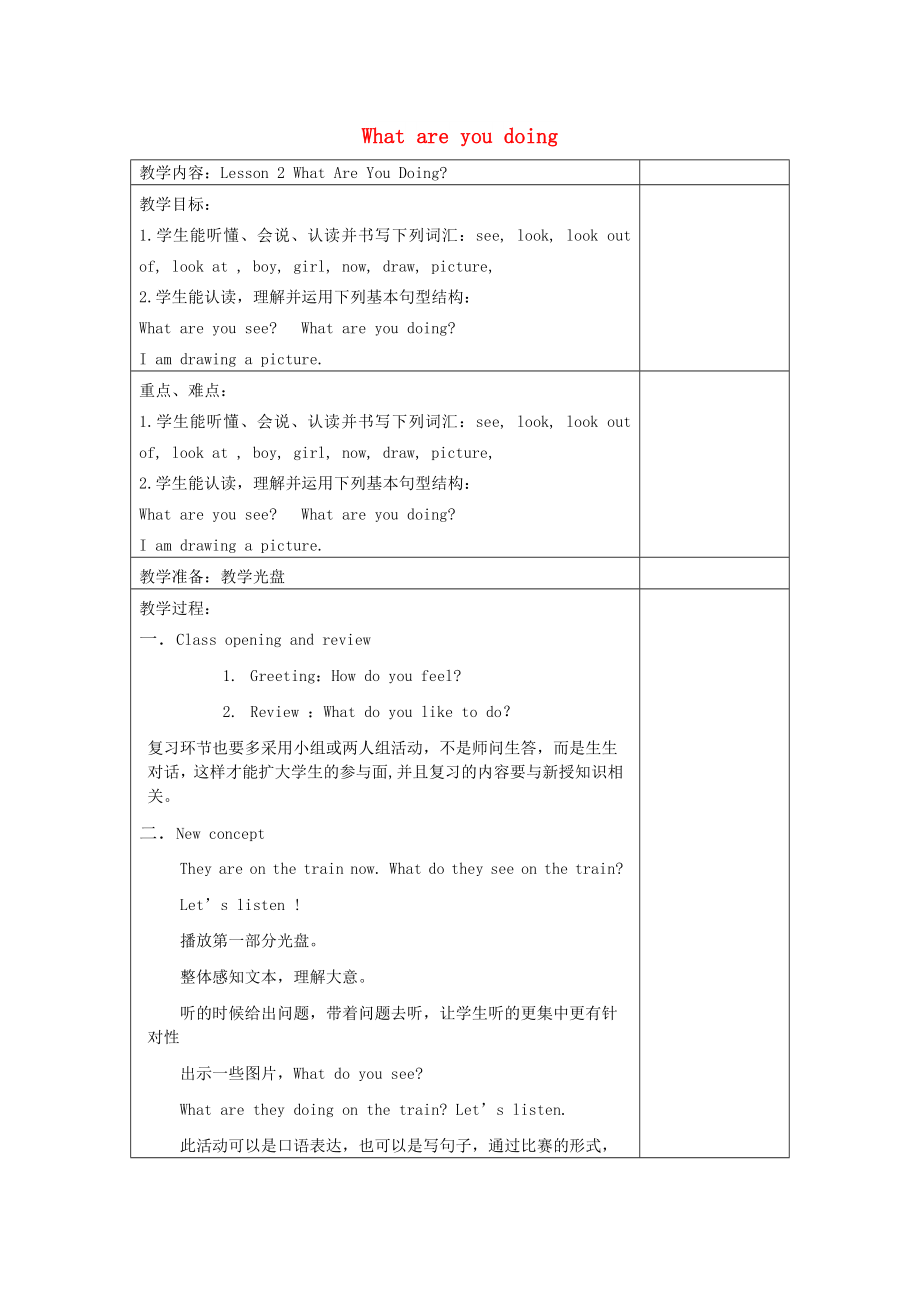《2022春五年級(jí)英語(yǔ)下冊(cè) Unit 1 Going to Beijing Lesson 2《What are you doing》教案1 (新版)冀教版》由會(huì)員分享��,可在線閱讀,更多相關(guān)《2022春五年級(jí)英語(yǔ)下冊(cè) Unit 1 Going to Beijing Lesson 2《What are you doing》教案1 (新版)冀教版(2頁(yè)珍藏版)》請(qǐng)?jiān)谘b配圖網(wǎng)上搜索��。
1��、What are you doing
教學(xué)內(nèi)容:Lesson 2 What Are You Doing?
教學(xué)目標(biāo):
1.學(xué)生能聽(tīng)懂��、會(huì)說(shuō)��、認(rèn)讀并書(shū)寫(xiě)下列詞匯:see, look, look out of, look at , boy, girl, now, draw, picture,
2.學(xué)生能認(rèn)讀��,理解并運(yùn)用下列基本句型結(jié)構(gòu):
What are you see? What are you doing?
I am drawing a picture.
重點(diǎn)��、難點(diǎn):
1.學(xué)生能聽(tīng)懂��、會(huì)說(shuō)��、認(rèn)讀并書(shū)寫(xiě)下列詞匯:see, look, look out of, l
2��、ook at , boy, girl, now, draw, picture,
2.學(xué)生能認(rèn)讀��,理解并運(yùn)用下列基本句型結(jié)構(gòu):
What are you see? What are you doing?
I am drawing a picture.
教學(xué)準(zhǔn)備:教學(xué)光盤(pán)
教學(xué)過(guò)程:
一. Class opening and review
1. Greeting:How do you feel?
2. Review :What do you like to do��?
復(fù)習(xí)環(huán)節(jié)也要多采用小組或兩人組活動(dòng)��,不是師問(wèn)生答,而是生生對(duì)話��,這樣才能擴(kuò)大學(xué)生的參與面,并且復(fù)習(xí)
3��、的內(nèi)容要與新授知識(shí)相關(guān)��。
二. New concept
They are on the train now. What do they see on the train?
Let’s listen !
播放第一部分光盤(pán)��。
整體感知文本��,理解大意��。
聽(tīng)的時(shí)候給出問(wèn)題��,帶著問(wèn)題去聽(tīng)��,讓學(xué)生聽(tīng)的更集中更有針對(duì)性
出示一些圖片��,What do you see?
What are they doing on the train? Let’s listen.
此活動(dòng)可以是口語(yǔ)表達(dá)��,也可以是寫(xiě)句子��,通過(guò)比賽的形式��,看哪一隊(duì)說(shuō)的最多或?qū)懙淖疃?�,激發(fā)學(xué)生參與的興致
播放第二部分光盤(pán)
培養(yǎng)學(xué)
4��、生根據(jù)要求抓住關(guān)鍵信息��,然后提煉信息��,完成任務(wù)��。
利用動(dòng)畫(huà)形式或其他運(yùn)動(dòng)的形式介紹現(xiàn)在進(jìn)行時(shí):I’m jumping
She is swimming.
They are talking…
現(xiàn)在進(jìn)行時(shí)強(qiáng)調(diào)正在進(jìn)行的動(dòng)作��,所以教師呈現(xiàn)給學(xué)生的一定是正在做的事��,持續(xù)播放的動(dòng)畫(huà)或動(dòng)作等��,更真實(shí)貼切��,利于學(xué)生理解和接受��。
播放整篇文本��,listen and read.
三. Practice
Classclosing
Homework:
Read the text.
Exercise book.
板書(shū)設(shè)計(jì):
Lesson 2: What are you doing?
What do you see? I see _________.
What is the boy doing now?
He is drawing a picture.
What is the girl doing now?
She is looking out of the window.
課后反思:
 2022春五年級(jí)英語(yǔ)下冊(cè) Unit 1 Going to Beijing Lesson 2《What are you doing》教案1 (新版)冀教版
2022春五年級(jí)英語(yǔ)下冊(cè) Unit 1 Going to Beijing Lesson 2《What are you doing》教案1 (新版)冀教版

